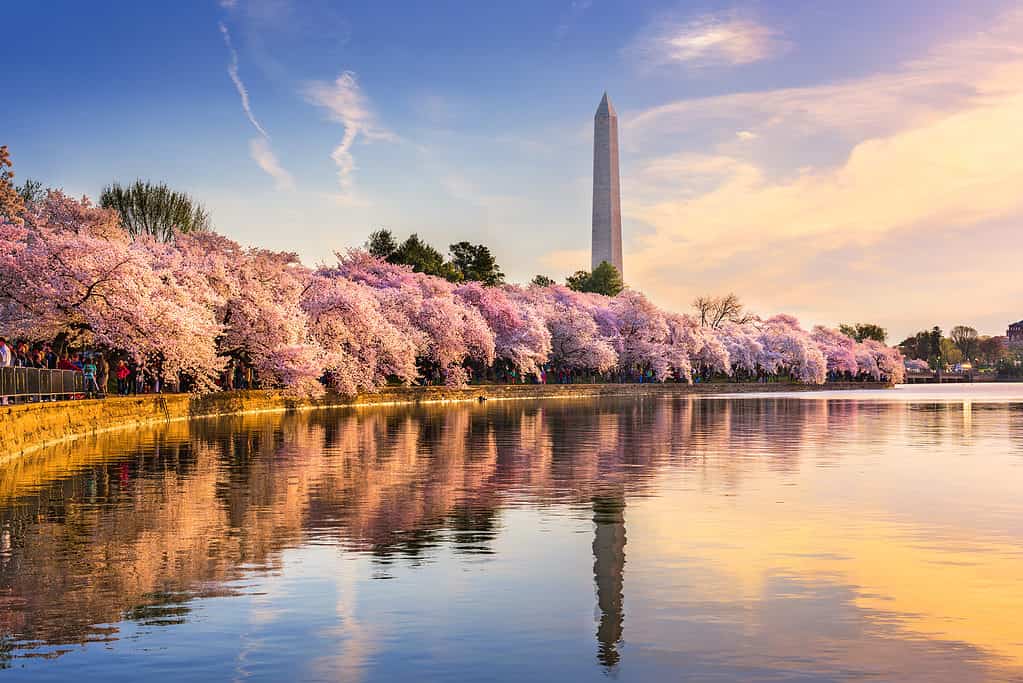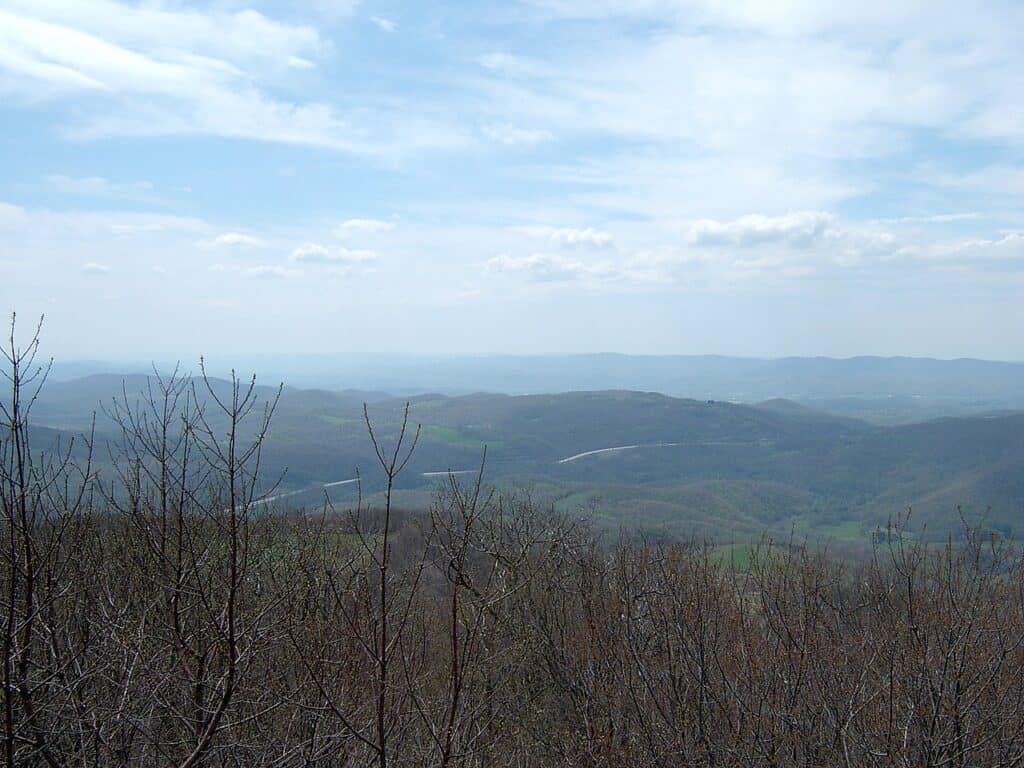Did you know that over 40% of Americans live in places with unhealthy air pollution levels? While most states in the United States have good air quality, some have worsening pollution conditions that cause their air quality to worsen as well. If these states do not make efforts to improve their air quality, those with respiratory infections and other medical conditions might suffer the consequences. The most important aspect of air quality is decreasing emissions and air particles that cause unsafe conditions. Find out which states have the worst air quality in the nation.
What Is Air Quality And How Is It Calculated?
Air quality is determined by whether the air is considered polluted or clean. Air quality is crucial to maintaining the health of humans and of the environment. The Air Quality Index (AQI) is a measurement of air quality. Measurements on the AQI range from 0 to 500 degrees. These measurements show how much pollution is in the air at a given time.
Five main air pollutants are tracked by AQI measurements. These include aerosols and airborne particles, nitrogen dioxide, carbon monoxide, sulfur dioxide, and ground-level ozone. Airborne particles and ground-level ozone are most threatening to human health. Ground-level ozone occurs when sunlight combines with chemical emissions that derive from the burning of fossil fuels. Airborne particles can come from atmospheric chemical reactions or from wildfires, construction sites, and the burning of fossil fuels. Both ground-level ozone and airborne particles are the main contributors to smog, which negatively impacts human health.
Ground-level ozone is specifically dangerous to those with respiratory diseases or asthma. Ozone can cause asthma attacks and shorten a person’s lifespan. Air particle pollution can affect the lungs and the bloodstream. Negative health effects that result from air particle pollution include asthma attacks, strokes, heart attacks, and lung cancer.
AQI measurements fall into certain brackets that determine the health risk posed to humans and the environment. The AQI brackets are listed in the table below.
Air Quality Index Measurements
| Measurement | Level of Concern |
|---|---|
| 0 to 50 | Good; little to no risk. |
| 51 to 100 | Moderate; those especially sensitive to air pollution are moderately at risk. |
| 101 to 150 | Unhealthy for Sensitive Groups; those sensitive to air pollution are at risk. |
| 151 to 200 | Unhealthy; general population is at partial risk, and those sensitive to air pollution are at high risk. |
| 201 to 300 | Very Unhealthy; all are at high risk to experience damaging health effects. |
| 301 to 500 | Hazardous; the general population will experience health effects. |
Top 10 States With The Worst Air Quality
While states like California endure plentiful amounts of air pollution, this does not mean that their AQI is exceptionally high. In fact, the states with the highest and most dangerous AQIs might be surprising to discover. Below describe the top 10 states with the worst air quality from lowest to highest AQI.
Alabama

Despite a significant decrease in air particle pollution in some of its cities, Alabama ranks tenth in the U.S. states with the worst air quality.
©iStock.com/Shackleford-Photography
The state of Alabama ranks #10 with an AQI of 46.6 and a population of 4.8 million. Cities in Alabama with the worst air quality due to ground-level ozone include Birmingham, Hoover, and Talladega. Air particle pollution has significantly decreased in these cities, as of 2020. Nevertheless, the three cities still experience mass amounts of air particle pollution, making them some of the worst in the United States when it comes to air quality.
Cities with the least amount of ground-level ozone in Alabama include Ozark, Gadsden, Scottsboro, and a few others. Alabama cities that decreased their air particle pollution and recorded exceptional levels of air particle pollution for the entirety of a year include Mobile, Daphne, and Fairhope.
District Of Columbia

After severe wildfires, the District of Columbia ranks ninth in the U.S. states with the worst air.
©iStock.com/SeanPavonePhoto
Washington, D.C., metropolitan area has a population of 6.3 million. As the capital of the United States, Washington, D.C., receives millions of visitors every year. It ranks #9 for worst air quality in the United States with an AQI of 46.8. Wood-burning stoves in D.C. residencies create 63% of winter air particle pollution in the city. The surrounding area also struggles with wildfire occurrences, which release particles into the air, too.
Washington, D.C., has fallen into the “very unhealthy” bracket of the AQI table following wildfire occurrences. Urban fires within the city release more contaminated particles than rural fires because urban fires burn plastics and waste. The area also struggles with an abundance of ozone pollution, which produces smog. Dust, the burning of fossil fuels, and air particles resulting from agricultural practices all contribute to Washington D.C.’s worsening air quality.
Maryland

While beautiful, Maryland suffers from intense smog and soot pollution.
©refrina/Shutterstock.com
Maryland ranks #8 in worst air pollution in the nation with a population of 5.9 million. Their AQI is 47.0, and the state suffers from intense smog and soot pollution. Although Maryland’s air quality has improved in the last 30 years, the state still ranks in the top smoggiest suburbs in the nation. Luckily, ozone pollution in Maryland has improved significantly, but air particle pollution and smog still plague the state, causing it to remain in the top 10 states with the worst air pollution.
Fossil fuel emissions in Maryland are the biggest contributors to ground-level ozone and air particle presence in the state. These emissions come from cars, buses, electric utilities, and industrial boilers. However, Maryland has fought back against air pollution. Overall emissions from vehicles and manufacturing have decreased, making Maryland’s air quality sit between the “good” and “moderate” brackets on the AQI table for most of the year.
Colorado

Just barely higher on the AQI scale than Maryland is Colorado, making it seventh out of the U.S. states with the worst air.
©vagabond54/Shutterstock.com
Colorado’s AQI is 47.1, placing it just barely above Maryland on the AQI rank at #7. Colorado’s population numbers 5.2 million. The World Health Organization recognized Denver, Colorado for its achievement of an acceptable air quality average, as of 2020. Unfortunately, Colorado’s air quality had been better in the past, meaning that improvement might be a long way off for the state, as conditions appear to worsen.
Factories, homes, cars, and several other sources that burn fossil fuels contribute to air pollution in Colorado. Most of Colorado’s air pollution derives from greenhouse gases like methane, carbon dioxide, and hydrofluorocarbons. The state does not limit emissions currently, but legislators have outlined a plan for companies to reduce their emissions. Several large corporations and manufacturers have committed to reducing pollutants before legislators implement mandates.
Tennessee And Indiana
Tennessee

Tying for fifth are Tennessee and Indiana. Pictured here is Oak Ridge, Tennessee.
©Appealbydesign/Shutterstock.com
Tennessee ties with Indiana for #5 on the list of states with the worst air quality. Tennessee and Indiana have an AQI of 47.5 and populations of 6.5 million each. Red Bank, Tennessee is the most polluted city within the state, and officials have urged it to take steps toward reducing its emissions and improving air quality. Most of the air pollution in Tennessee is a result of combustion sites, including vehicle emissions.
Tennessee extracts and transports large amounts of marble, sand, and gravel. The industry requires trucks and other sources of transportation for goods on the roadways. These larger vehicles require diesel fuels and emit more pollutants when compared to the average car. Pollutants from trucks and other large vehicles include fossil fuels and rubber particles. Other Tennessee pollution sources consist of construction sites, factories, mining sites, forest fires, and power plants.
Indiana

With an equal score in AQI, Indiana ties with Tennessee.
©Patricia Elaine Thomas/Shutterstock.com
Indiana ranks #5 in AQI with Tennessee, and its most polluted city is Bloomington, Indiana. On the other hand, the city with the cleanest air quality is Evansville, Indiana. Population, energy consumption, and vehicle emission increases have all contributed to Indiana’s air quality. However, with these increases came a 74% decrease in six main air pollutants, meaning that the state has made efforts to improve air quality.
Ground-level ozone is a major problem in Indiana, but it is not necessarily the sole result of emissions. Indiana has a high level of ozone due to natural decomposition in its forests and habitats. Thus, natural ozone will always remain in the state. Officials will only be able to make efforts toward decreasing the anthropogenic sources of ground-level ozone. Indiana has also introduced carbon trading, which allows industries producing carbon dioxide a way to dispose of it that decreases emissions and aids in environmental stability.
West Virginia

West Virginia ranks fourth, and many of its counties still receive continually worsening ozone scores.
©Brian M. Powell (user Bitmapped on en.wikipedia) / Creative Commons – License
The state of West Virginia ranks #4 in states with the worst air quality with a population of 1.9 million. West Virginia has an AQI of 47.6. Although the state has made consistent efforts to improve air particle pollution, ground-level ozone continues to worsen. Nevertheless, many counties within West Virginia received better grades on air particle assessments than they had in previous years.
Reports indicate that ozone levels continue to grow in the state and that many counties received worse grades on ozone assessments than in the past. The county of Greenbrier, though, has consistently maintained clean air and low ozone levels. On the other hand, numerous counties in West Virginia saw more unhealthy ozone level days than in the past.
Georgia And Ohio
Georgia

Another tie makes up the second spot. Georgia (pictured) ties with Ohio for AQI score.
©iStock.com/Sean Pavone
Tied for #2 on the rank of states with the worst air quality are Georgia and Ohio. Georgia has a population of 9.9 million, and Ohio’s population numbers 11.6 million. The two states’ AQIs measure 48.2. Georgia’s industries include agriculture, mining, textile manufacturing, transportation, and more. Georgia’s vast number of major industries cause an abundance of air pollution. Large population numbers also contribute to constant pollution within the state.
Emissions from cars are one of the main sources of pollution for the state of Georgia. For one, increasing car ownership means that more pollutants are released as people take to the roads. In addition, the transportation of goods by large vehicles is necessary to keep Georgia’s industries running. These large vehicles like semi-trucks emit a substantial number of pollutants. Natural gas and coal are also used by many Georgia facilities to produce energy for homes and businesses. The lack of sustainable energy production within the state means that more pollutants are released every day.
Ohio

With its wide variety of industries, Ohio has poor AQI levels.
©iStock.com/Corey B. Stevens
Ohio has had a reputation for having a wide variety of industries for decades. Manufacturing and truck transportation emit pollutants at a consistent rate. Furthermore, vehicle emissions are a major pollutive source. Many of the main cities in Ohio are hours away from each other, resulting in longer commutes for those that work in the city. Longer time on the road coupled with traffic means that emissions increase.
Smoke from forest fires, power plants, and factories also contributes to fossil fuel emissions. During cold winters, the demand for heat and electricity in Ohio residencies increases, resulting in the use of large amounts of coal and natural gas to power homes. Finally, air particles result primarily from construction and extraction. Both activities stir up minerals, dust, and dirt within the Earth that are eventually released into the atmosphere.
Utah

With an AQI of 51.2, Utah has the worst air quality of all U.S. states.
©iStock.com/Desertsolitaire
Utah is the state with the worst air quality in the United States. At rank #1, Utah has a population of 2.6 million and an AQI of 51.2. Utah’s AQI makes it the only state in the nation to fall into the “moderate” bracket on the AQI table based on average AQI across the entire state. Salt Lake City, Utah has always received a failing grade for ground-level ozone and air particle assessments.
Much of the pollution in Utah is centered around Salt Lake City, whose air quality results in approximately 450 fatalities per year. Air pollution in Utah is mainly a result of car emissions. Heating in homes and businesses is also a large contributor to air pollution in the state. Surprisingly, industry emissions make up the lowest percentage of overall emissions in Salt Lake City, Utah. The city, along with many other cities in Utah, suffers from temperature inversion, which traps polluted air in the lowest layer of the atmosphere.
Improving Air Quality
In 2022, the American Lung Association reported that over two million more people were living in areas with unhealthy air conditions than in 2021. In fact, 2020 through 2022 was the worst period for air quality since the beginning of such reports. Air quality in these areas reached “very unhealthy” and “hazardous” levels. Therefore, improving air quality is the key to avoiding health problems that many susceptible Americans might face.
Maintaining clean air is crucial to the survival of the environment, and there are many ways to mitigate the effects of air pollution. Lobbying for the regulation of air pollutants can influence legislators to take initiative and propose bills that can help to improve air quality. Legislation can force large corporations to act sustainably, decreasing the amount of waste, emissions, and pollutants that they release into the environment.
Government action takes time to achieve, so Americans can take certain steps on their own to help decrease air pollution. The main cause of air pollution in every state covered has been vehicle emissions. Riding a bike, taking public transportation, driving electric cars, or walking can help to reduce fossil fuel emissions.
Stay Aware
Furthermore, being aware of air particles and ozone levels in your area can help you determine what steps to take next. Knowing when elevated air particles and ozone levels are forecasted allows you to decrease your waste and emissions. On days with high air particle levels, you can do your part in helping the environment through the steps listed below:
- Avoid burning trash, grasses, or leaves that might emit smoke and release air particles into the atmosphere.
- Avoid using a grill to cook food.
- Reduce the number of times you drive a car or other vehicle.
- Avoid using lawnmowers or other lawn equipment powered by gas.
- Avoid using a fireplace or wood-burning stove.
When ozone levels begin to increase, the following steps can help you reduce ozone levels in the environment:
- Set air conditioners at higher settings, around 77 degrees.
- Avoid using hairspray and spray deodorant.
- Carpool, use public transportation, or reduce the number of trips you take in a vehicle.
- Walk or ride a bike to arrive at your destination.
Summary Of The 10 States With The Worst Air Quality
| Rank | State | Air Quality (AQI) |
|---|---|---|
| 10 | Alabama | 46.6 |
| 9 | Washington, District Of Columbia | 46.8 |
| 8 | Maryland | 47 |
| 7 | Colorado | 47.1 |
| 5 (tied) | Tennessee | 47.5 |
| 5 (tied) | Indiana | 47.5 |
| 4 | West Virginia | 47.6 |
| 2 (tied) | Georgia | 48.2 |
| 2 (tied) | Ohio | 48.2 |
| 1 | Utah | 51.2 |
The photo featured at the top of this post is © Michael Andrew Just/Shutterstock.com
Sources
- American Lung Association, Available here: https://www.lung.org/media/press-releases/state-of-the-air-alabama
- National Oceanic and Atmospheric Administration, Available here: https://scijinks.gov/air-quality/#:~:text=Air%20quality%20is%20measured%20with,of%20pollution%20in%20the%20air.&text=Air%20quality%20is%20a%20measure,or%20polluted%20the%20air%20is
- IQAir, Available here: https://www.iqair.com/usa/washington-d-c
- IQAir, Available here: https://www.iqair.com/us/usa/maryland
- IQAir, Available here: https://www.iqair.com/us/usa/colorado
- IQAir, Available here: https://www.iqair.com/us/usa/tennessee
- IQAir, Available here: https://www.iqair.com/us/usa/indiana
- IQAir, Available here: https://www.iqair.com/us/usa/georgia
- IQAir, Available here: https://www.iqair.com/us/usa/ohio
- IQAir, Available here: https://www.iqair.com/us/usa/utah/salt-lake-city
- American Lung Association, Available here: https://www.lung.org/research/sota/key-findings
- USA, Available here: http://www.usa.com/rank/us--air-quality-index--state-rank.htm?hl=FL&hlst=FL
- Stop Global Destruction, Available here: https://www.stopglobaldestruction.org/how-to-stop-air-pollution/?gclid=Cj0KCQiAlKmeBhCkARIsAHy7WVuSCp-DuNrugO4NcpBtncX6aatDch-KgSuBsZXqRGw5oKOY378S58IaAsjyEALw_wcB
FAQs (Frequently Asked Questions)
Which state has the worst air quality in the nation?
Utah has the worst air quality with an AQI of 51.2.
What can people do to reduce air pollution?
Decreasing vehicle use is the best way to reduce air pollution. Commute options include walking, riding a bike, carpooling, and taking public transportation.
What pollutants cause a high AQI?
The main pollutants that contribute to an increased AQI and health problems are ground level ozone and air particle pollution.
Thank you for reading! Have some feedback for us? Contact the AZ Animals editorial team.







